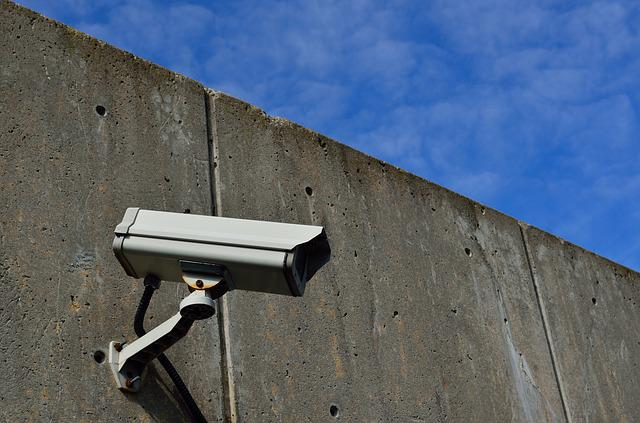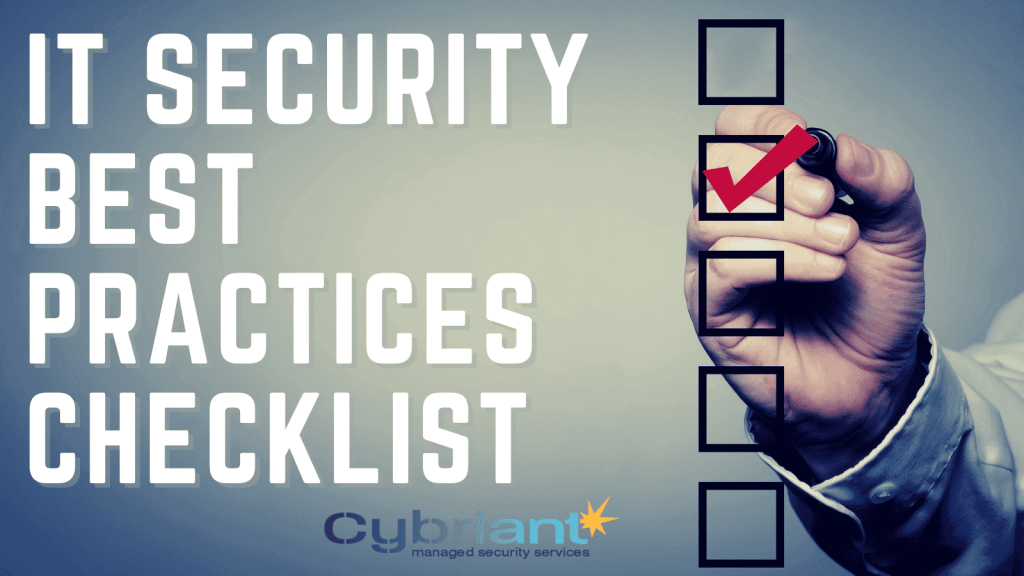Check out this IT security best practices checklist to make sure your company is safe from cyberattacks including sensitive data. Included are tips for setting up firewalls, remote access, mobile devices, encrypting data, and creating passwords that are tough to crack.
As a CEO, you know that data security is critical to the success of your company. But what are the best practices for protecting your data? Here is an IT security requirements checklist to help protect your business.
What are IT security best practices?
IT security best practices are the measures taken to protect your data from cyberattacks. These cyber security guidelines can include setting up firewalls, encrypting data, daily monitoring for cyber events that may happen on your network, and simple tasks like creating strong passwords.
By taking these precautions, you can make it much more difficult for hackers to access your data.
#1. Have a Layered Approach to Network Security
IT security best practices are constantly evolving, but some basic principles remain the same. First and foremost, it is important to have a layered approach to security to protect critical data, with different solutions in place to protect different parts of the system.
The layered approach to security is a comprehensive strategy that takes into account all aspects of security, from people to products to technology.
By taking a layered approach, businesses can better protect themselves against threats and minimize the impact of security breaches.

Three Layers of Security
The first layer of security is people. This includes ensuring that employees are properly trained and aware of security procedures.
The second layer is products. This includes using products that are designed to be secure and compliant with industry standards.
The third layer is technology. This includes using technology to monitor and protect data and resources. By taking a layered approach to security, businesses can ensure that they have the best possible protection against threats.
Managed security services can be used to supplement in-house resources by providing security system monitoring, network security audits, and 24/7 cyber security, providing an extra layer of protection.
#2. Maintain Up-to-Date Software, Patches, and Vulnerabilities
Another important best practice is to keep systems, software, and security patches up to date, as this helps to close any vulnerabilities that may have been exploited.
Managed security services can help you keep your software updated, patched, and free of vulnerabilities, which will help avoid security threats. One of the benefits of managed security services is that they can provide you with around-the-clock monitoring and support.
This means that if there are any changes to your software or if any new vulnerabilities are discovered causing potential security risks, you can be sure that your managed security service provider will take care of it for you.
Additionally, managed security services can also help you to keep your software license up to date. This can save you money in the long run, as out-of-date software is often more vulnerable to attack. In summary, managed security services can provide you with peace of mind when it comes to keeping your software updated and secure.

#3. Prepare an Incident Response Plan
It is essential to have a plan in place for how to respond in the event of a security breach.
An incident response plan is a critical part of any organization’s IT security best practices checklist. By definition, an incident is an event that has the potential to disrupt normal operations or pose a threat to safety, security, or business continuity.
An incident response plan is a document that outlines the steps that should be taken in the event of an incident. The goal of an incident response plan is to minimize the impact of an incident and to restore normal operations as quickly as possible.
Managed security services providers can help organizations create and test their incident response plans to ensure that they are up to date-and ready to be implemented in the event of an actual incident.

#4. Encrypt Data
Data encryption is the process of transforming readable data into an unreadable format. This is done using an algorithm and a key. The data can only be decrypted and read by someone who has the key.
Encryption is also used to ensure the privacy of communications, such as email and instant messages. When data is encrypted, it is transformed into ciphertext. This makes it difficult for someone who does not have the key to read the data. However, the ciphertext can be decrypted using the correct key.
Data encryption is a powerful tool for protecting information and ensuring privacy.

#5. Implement Access Control Measures
There are two primary types of access control measures: physical security and digital security.Physical security measures are designed to prevent unauthorized access to physical devices and locations, while digital security measures are designed to prevent unauthorized access to digital data and systems.
Common physical security measures include locks, alarms, and physical barriers, while common digital security measures include passwords, encryption, and firewalls.
By implementing both physical and digital security measures, organizations can effectively protect their assets from unauthorized access.
Related: Top Cyber Security Websites

#6. Train Employees on Cybersecurity Best Practices
This helps to ensure that employees are aware of how to protect data and what to do in the event of a security breach. In today’s world of remote work and employees using their own devices, unauthorized users mustn’t have access to sensitive data.
Phishing is one of the most common types of cyber attacks, and it can be difficult to spot phishing emails if you don’t know what to look for. By teaching your employees about phishing scams, you can help them to recognize phishing emails and protect your business from attack.
Employee cybersecurity training can also help to raise awareness of other potential threats, such as malware and viruses. By providing employees with the knowledge they need to stay safe online, you can help to reduce the risk of a cyber attack on your business.
In addition, user security measures such as password requirements can help protect your employees from cyber threats.
#7. Monitor Endpoints that Access Company Data
A company’s data is one of its most valuable assets, and it is essential to take steps to protect it. One way to do this is to monitor endpoints that have access to company data.
An endpoint is any device or software that can access company data. This includes laptops, desktop computers, smartphones, tablets, and even IoT devices.
By monitoring endpoints, you can ensure that only authorized individuals have access to company data. In addition, you can also monitor for suspicious activity and take steps to prevent data breaches. With the increase in remote work, mobile device vulnerability is a major concern for organizations.
Endpoint security solutions like EDR and MDR can help to detect and prevent unauthorized access to data, as well as identify malicious activity. By monitoring endpoints, companies can reduce the risk of data breaches and ensure that their data is safe.

#8. Prepare for the Unknown
Prevention is worth a pound of cure in cybersecurity. It is impossible to always know the next steps or tactics hackers and nation-state groups will take to acquire your data. It’s best to be prepared with 24/7 monitoring and a team of security analysts with eyes on your network so they can stop attacks before they happen.
Managed security services can help your business identify vulnerabilities and close them before an attack happens. They can also provide 24/7 support to ensure that your business is prepared for any eventuality.
Not only will this save you money in the long run, but it will also give you peace of mind knowing that your business is protected. Many organizations don’t the bandwidth for log monitoring, updating security vulnerabilities, and keeping operating systems up-to-date. This is where MSSPs like Cybriant can help.
By following these basic best practices, your organization can help to keep its systems safe from attack.

Why are IT security best practices important?
IT security best practices are important because they help to protect your data from cyberattacks. By taking measures to secure your data, you can make it much more difficult for hackers to access it. This can help to prevent the theft of sensitive information and reduce the risk of data breaches.
In addition, IT security best practices can also help to protect your business from other types of cyber attacks, such as malware and viruses. By taking steps to secure your systems, you can help to reduce the risk of a cyber attack on your business.
What are the benefits of using IT Security Best Practices?
The benefits of using managed security measures include:
Protection of data
By taking measures to secure data, organizations can help to prevent it from being accessed by unauthorized individuals.
Prevention of data breaches
By making it more difficult for hackers to access data, digital security measures can help to prevent data breaches.
Improved compliance
In many industries, there are regulations in place that require organizations to take measures to protect data.
Reduced costs
Data breaches can be costly, both in terms of the damage caused and the cost of recovery. By taking measures to prevent data breaches, organizations can help to reduce these costs.
Improved customer satisfaction
By taking measures to protect customer data, organizations can help to improve customer satisfaction. This can lead to increased loyalty and repeat business.
Increased competitive advantage
In today’s business environment, data security is becoming increasingly important. Organizations that take measures to secure their data can gain a competitive advantage over those that do not.
Small Business Cyber Security Checklist
As a small business owner, you know that cybersecurity is important. But with so many things to think about, it can be hard to know where to start. That’s why we’ve put together this small business cybersecurity checklist. By following these simple steps, you can help protect your business from cyber attacks.
- Know who has access to your systems. Make sure you have a process in place for granting and revoking access to your systems. And have a way to track who has accessed what, when they accessed it, and what they did while they were logged in.
- Keep your software up to date. Install security updates as soon as they’re released. This includes not only your operating system, but also any applications you’re using.
- Use strong passwords and multi-factor authentication Change your passwords regularly, and make sure they’re strong – at least 8 characters, with a mix of upper- and lower-case letters, numbers, and symbols.
- Back up your data regularly. This way, if you are attacked and information is encrypted or lost, you’ll be able to restore it from your backup.
- Educate your employees about cybersecurity threats. Make sure your employees know how to spot a phishing email, for example, and what to do if they think they’ve been attacked.
- Review your security posture regularly. Conduct regular security audits, and make sure you have the appropriate security measures in place for your business.
By following these simple steps, you can help protect your small business from cyber-attacks. Cybersecurity is an important part of running a business, and it’s something that all businesses should take seriously.
If you have any questions about small business cybersecurity, or if you’d like to learn more about how to protect your business, please contact us. We’re here to help.
Application Security Best Practices Checklist
As any security professional knows, application security is a critical part of protecting data and ensuring that systems are secure. There are a variety of best practices that should be followed in order to ensure the security of applications, and a comprehensive application security best practices checklist should include all of the following items:
Identify and assess risks:
The first step in application security is to identify and assess the risks associated with the application. This includes identifying any potential vulnerabilities that could be exploited by an attacker.
Develop a security plan:
Once the risks have been identified, it is important to develop a security plan that includes measures to mitigate those risks. This may include steps such as implementing authentication and authorization controls, encrypting data, and hardening servers.
Implement security controls:
The next step is to implement the security controls that have been selected as part of the security plan. This may include installing firewalls, application gateways, and intrusion detection/prevention systems.
Test and evaluate controls:
It is important to regularly test and evaluate the effectiveness of the security controls that have been implemented. This helps to ensure that they are properly configured and functioning as expected.
Monitor and respond to threats:
Finally, it is important to monitor for potential threats and incidents and to have a plan in place for how to respond if an attack does occur. This may include steps such as identifying and isolating compromised systems, restoring backups and notifying authorities.
Following these best practices will help to ensure the security of applications and protect data from potential attackers.
Enterprise Network Security Best Practices
- Use strong passwords and change them often.
- Install a firewall and use it to restrict access to only authorized users.
- Use anti-virus software and keep it up to date.
- Scan your computer for malware and spyware on a regular basis.
- Create an incident response plan and practice it regularly.
- Educate your employees about security best practices and make sure they follow them.
- Back up your data regularly and store the backups in a secure location.
- Restrict access to sensitive data to only authorized users.
- Use encryption to protect sensitive data transmitted over the network.
- Work with a trusted MSSP partner that will protect your network 24/7.
Computer Security Best Practices
1. Keep your operating system and software up to date One of the simplest, and most effective, ways to improve your computer security is to keep your operating system and software up to date with the latest security patches. These patches are released periodically by the developers of your software in order to address newly discovered security vulnerabilities. By keeping your software up to date, you can help protect your computer from the latest security threats.
2. Use a strong password Another simple way to improve your computer security is to use a strong password. A strong password is one that is difficult for others to guess and contains a mix of upper and lowercase letters, numbers, and symbols. Avoid using easily guessed words like “password” or your name. Instead, try to come up with a password that is both difficult to guess and easy for you to remember.
3. Avoid using public Wi-Fi networks Public Wi-Fi networks are convenient, but they can also be dangerous. When you connect to a public Wi-Fi network, you are sharing that connection with all of the other users on that network. This means that if one user on the network is compromised, all of the other users on the network are also at risk. To help protect your computer from security threats, avoid using public Wi-Fi networks whenever possible.
4. Install a reputable antivirus program Another important step in securing your computer is to install a reputable antivirus program. Antivirus programs work to protect your computer from malicious software, or malware, that can seek to damage or destroy your data. There are many different antivirus programs available, so be sure to do some research to find one that best meets your needs.
5. Back up your data regularly One of the most important computer security best practices is to back up your data regularly. In the event that your computer is lost, stolen, or damaged, you will be glad you have a backup of your important files and data. There are many different ways to back up your data, so be sure to choose a method that is right for you.
6. Be careful what you click One of the easiest ways for malware to find its way onto your computer is by clicking on malicious links or attachments. When you receive an email from an unknown sender, be wary of any links or attachments that are included. Even if you know the sender, be cautious of links and attachments, as they may still be malicious. If you are unsure whether or not a link or attachment is safe, err on the side of caution and do not click it.
7. Use caution when downloading files Another way that malware can find its way onto your computer is by downloading infected files from the internet. When you download files from the internet, be sure to scan them with your antivirus program before opening them. If you are unsure whether or not a file is safe, it is best to avoid downloading it altogether.
8. Keep your personal information privat When you are online, be careful about sharing your personal information. Personal information such as your name, address, and date of birth can be used by criminals to commit identity theft. Be sure to only share your personal information with websites that you trust and look for the https:// in the URL before entering any sensitive information.
9. Be aware of social engineering scams Social engineering scams are becoming increasingly common. In a social engineering scam, a criminal will attempt to trick you into giving them your personal information or login credentials. They may do this by posing as a legitimate company or person, or by sending you an email that looks like it is from a legitimate source. Be sure to exercise caution when giving out your personal information and be sure that you are dealing with a reputable source before giving out any sensitive information.
10. Keep your software up to date One of the best things you can do to keep your computer secure is to keep your software up to date. Software companies regularly release updates that include security patches for newly discovered vulnerabilities. By keeping your software up to date, you can help protect your computer from the latest security threats.
Following these computer security best practices can help you keep your computer safe from harm. However, even if you take all of the necessary precautions, there is always a possibility that your computer could be compromised.
G Suite Security Checklist
1. Enable 2-step verification for all users: 2-step verification adds an extra layer of security by requiring users to enter a code from their phone in addition to their password when signing in. This helps ensure that only authorized users have access to your data.
2. Set up a strong password policy: Require all users to set strong passwords that are difficult to guess. Additionally, consider requiring users to change their passwords on a regular basis.
3. Use security keys: Security keys add an extra layer of security by requiring users to insert a physical key into their computer when signing in. This helps ensure that only authorized users have access to your data.
4. Restrict access to sensitive data: Only give users access to the data that they need to do their job. For example, if a user only needs to read data, don’t give them write access.
5. Monitor activity: Use Google’s built-in activity monitoring tools to keep track of what users are doing in your account. This can help you spot suspicious activity and take action accordingly.
6. Keep your software up to date: Regularly update your operating system and applications to ensure that you have the latest security patches.
7. Back up your data: Make sure to regularly back up your data to protect against accidental deletion or data loss.
8. Use encryption: Encrypt sensitive data so that it is difficult for unauthorized users to access it.
9. Review permissions: Periodically review the permissions that you have granted to users and apps. Revoke access for any users or apps that no longer need it.
10. Get help: If you are not sure how to set up your account for optimal security, consider hiring a professional to help you.
IT security methods, like two-factor authentication and physical security keys, can help prevent unauthorized access to your G Suite account. Be sure to enable these features for all users in your organization.
MSSP Checklist
An MSSP should have a robust compliance program in place, which includes regular risk assessments, vulnerability scanning, and incident response planning. They should also have experience with both private and public cloud environments. Look for an MSSP that can provide tailored security solutions to meet your specific needs.
When selecting an MSSP, be sure to ask about their:
- Compliance program
- Risk assessment process
- Vulnerability scanning capabilities
- Incident response plan
- Public and private cloud experience
- Tailored security solutions
MSSPs can be a valuable asset to any organization, providing expert guidance and 24/7 monitoring to help keep your data and systems safe. Be sure to select an MSSP that has the experience and capabilities to meet your specific needs.
Network Security Testing Checklist
Network security testing is a process of identifying potential vulnerabilities in a network and taking steps to mitigate them. The goal of network security testing is to ensure that data passing through the network is safe from eavesdropping or tampering. There are many different types of tests that can be performed on a network, but there are some common elements that should be included in any network security testing checklist.
1. Test the network perimeter: The first step in any network security testing checklist should be to test the network perimeter. This includes testing for weak passwords, open ports, and vulnerabilities that could allow an attacker to gain access to the network.
2. Test internal systems: Once the perimeter has been tested, the next step is to test internal systems. This includes testing for vulnerabilities that could allow an attacker to gain access to sensitive data or disrupt service.
3. Test for compliance: The final step in any network security testing checklist is to test for compliance. This includes verifying that the network is configured correctly and meets all applicable security standards.
Network security testing is an important part of keeping data safe. By following a network security testing checklist, organizations can ensure that their networks are secure and compliant with all applicable security standards.
Website Security Plan Checklist
A website security plan should include elements such as penetration testing, vulnerability scanning, and risk assessment.
In order to create a comprehensive website security plan, you should consider the following website security best practices:
1. Conducting regular penetration tests and vulnerability scans
2. Implementing strong authentication and authorization measures
3. Encrypting all data in transit
4. Monitoring activity logs for unusual or suspicious behavior
5. Restricting access to sensitive areas of the website
6. Training employees on cybersecurity best practices
7. Having a plan in place for responding to incidents
8. Keeping up-to-date with security patches and software updates.
9. Regularly backing up all data and storing it offsite
10. Working with a reputable cybersecurity company to help you create and implement a comprehensive website security plan.
New CISO Checklist
Congratulations on your new role as Chief Information Security Officer. Within your first ninety days, there are quite a few items to accomplish. The following checklist will help you get started on the right foot.
1. Define your security strategy.
2. Assess your organization’s risk posture.
3. Create a roadmap for improving your cybersecurity posture.
4. Draft policies and procedures for your team.
5. Implement security awareness and training programs.
6. Select and implement security technologies.
7. Monitor and respond to cybersecurity incidents.
8. Report to the board of directors or senior management on your progress.
Completing these tasks within your first ninety days will set you up for success in your new role as CISO. Stay organized, keep track of your progress, and reach out for help when needed. With careful planning and execution, you will be well on your way to protecting your organization’s data.
Home Network Security Checklist
If you’re looking to improve the security of your home network, using a computer security guide is an excellent place to start. A computer security checklist can help identify any areas that could benefit from being better protected. It’s important to be aware of how you connect various devices to your home network, ensuring they are authenticated and that the traffic is encrypted. You should also be mindful of what you’re accessing while connected to public networks. Regularly running updates on all hardware and software can also add another layer of protection. A computer security guide can be useful in determining best practices for home network security and other computer-related issues.
Cyber Security Readiness Checklist
An effective cyber security readiness checklist should be managed by managed security services. This can help ensure that organizations are prepared for cyber threats posed by malicious actors. Such managed services provide comprehensive assessments to establish coverage gaps, as well as ongoing monitoring and system maintenance designed to prevent breaches in data security. In addition, managed services can help organizations incorporate best practices for secure operations, such as strong password protection and encryption of data transmission. Organizations must take steps to keep their infrastructure secure; using a managed service is an important step toward this goal.
Security Requirement Checklist
- Access control: Does the system restrict access to only those users who are allowed to use the system?
- Authentication: Is there a way of verifying the identity of a user before they can access the system?
- • Password expiration: Are passwords set to expire after a certain period of time?
- Data encryption: Is data encrypted when stored and transmitted?
- System audit: Is there a system in place to record changes made to the system, such as user activity or file modifications?
- Secure backup: Are backups created on a regular basis and securely stored?
- Intrusion detection: Is there a system in place that can detect attempts to access the system without authorization?
- Firewalls: Are firewalls in place to protect against malicious traffic and unauthorized access?
- Vulnerability scanning: Is vulnerability scanning conducted regularly on the system?Patch management: Are patches applied as soon as they become available from the vendor
- Intrusion prevention: Are steps taken to prevent malicious traffic from entering the system?
- Two-factor authentication: Is two-factor authentication in place for secure user logins?
- Secure software development: Are security best practices being followed during the development and testing of any software used by the system?
- User education: Are users educated on the importance of security and how to help protect the system?
- Disaster recovery: Is there a documented disaster recovery plan in place for the system, in case of an emergency?
- Logging and monitoring: Is there a system in place that logs user activity and monitors for suspicious behavior or anomalies?
- Physical security: Are there measures in place to ensure the physical security of any system hardware and/or data centers?
- Incident response plan: Is there a documented incident response plan in place for responding to any potential security breaches or incidents?
- Compliance with laws and regulations: Are steps taken to ensure that the system is compliant with any applicable laws and regulations?
- Regular reviews: Are regular reviews conducted on the security measures in place to ensure that the system remains secure?
- Penetration testing: Is penetration testing conducted regularly to identify any potential weaknesses in the system’s security?
- Security policies: Are written security policies in place and enforced to ensure the secure use of the system?
- Secure storage of data: Is there a secure storage solution for any sensitive or personal data stored by the system?
- Data destruction: Are steps taken to securely destroy data after it is no longer needed?
- Vendor security review: Is there a process in place to review any third-party vendors that have access to the system or its data?
- User rights management: Are user rights managed appropriately and regularly reviewed for accuracy?
- Third-party risk assessment: Is there an ongoing risk assessment process in place to identify and mitigate any potential security risks from third-party vendors or service
- Endpoint security: Is endpoint security in place for any mobile devices or computers used to access the system?
- Automated monitoring: Is there an automated system that can monitor suspicious activity and report it back to administrators?
- Network security: Is there a system in place to protect the network from malicious traffic and unauthorized access?
- Application security: Are steps taken to ensure the secure use of any applications used by the system?
- Security awareness training: Are users regularly trained on security best practices and aware of potential risks?
- Data encryption: Is data encrypted when stored and in transit to protect it from unauthorized access?
- File integrity monitoring: Is there a system in place that monitors for any unauthorized files or system changes?
Conclusion
By taking the time to implement these measures, you can help protect your company from cybersecurity threats and data breaches. If you’re not sure where to start or feel like you’re falling behind, don’t worry. Cybriant offers gap analyses to help businesses identify their specific security needs. Learn more today.



